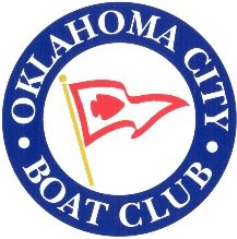Early History
The Oklahoma City Boat Club (OCBC) was originally founded on Lake Overholser in 1930 when a group of sailing and boating enthusiasts formed the Oklahoma City Yacht Club, as it was called at that time. Times were hard because of the Great Depression, but with a great deal of creativity and "sweat equity" from the membership a number of improvements were made to the property, including a two-story clubhouse by 1933, housing a membership of 25. The club burgee consisting of Indian arrowhead of red on a white background with a red border was adopted in 1932. With the advent of World War II many of the members were enlisted or inducted into the Armed Forces and club activities had almost ceased when the clubhouse burned down in 1942 with its furnishings and locker room contents. Several boats beached nearby also burned.
About this time a new reservoir, Lake Hefner, was being built by the city to take care of future population growth. The design of this lake showed that it would be much more suitable for sailing when filled, so several people from the old Overholser sailing clubs decided to establish a new sailing club on Lake Hefner. Organizational meetings took place in 1943 and the club was incorporated in 1944 under the name of the Oklahoma City Boat Club, Inc. During the next two years before any water flowed into the reservoir, the sites for the harbor, docks and clubhouse were staked out and docks and rip rapping were built. A clubhouse was constructed in 1949. The filling of the reservoir was a very slow process and it was not until 1958 that enough water was in the harbor basin to allow sailing from the docks. Before that boat launchings were from shore points or from the City Harbor docks. For that reason all boats were centerboards during the early days, primarily of the Snipe class.
Growth of the Physical Plant
The club continued to grow and prosper and many projects were carried out, all funded by the membership with the use of club labor wherever possible. Some of the club improvements in the 1960s included an extension of fencing, installation of a concrete ramp at the NW corner of harbor, expanded parking and landscaping, expansion of the north harbor, construction of a retaining wall and ramp and, enlarged the trailer parking lot and lights A breakwater was built for the south harbor, more floodlights were installed, a new south dock and slips were constructed for 52 boats and the east pond was filled to create more parking. Members also constructed a 1000-pound capacity hoist, later increased to 2000 pounds and then to 6000 pounds with a concrete slab.
Improvements to the clubhouse included the addition of a new room to clubhouse with a tiled locker room. Further improvements included the installation of a water supply, which allowed the construction of restrooms, showers, water fountains and a galley. Central heating was installed as well as a telephone. An observation deck was constructed on the clubhouse roof.
On September 14, 1968, fire razed the clubhouse with damage amounting to some $20,000, necessitating a complete rebuilding of the clubroom. Members sustained a complete loss of gear in the locker room. The clubhouse was rebuilt giving us a very improved facility over the old one.
During the decade of the 1970s the north parking lot was paved including the entrance driveway. The flagpole with its decorative foundation was erected.
In the 80s the south harbor was dredged and the clubhouse was expanded to the east. The meeting room was enlarged and a new locker area was constructed. A deck was constructed on the west side of the clubhouse and extensive landscaping was begun.
Several new projects were begun and completed during the 90s. These included building of the north sea wall, purchase and installation of the large west hoist and pad, expansion of the south side with a new fence, followed by construction of a new trailer lot supplied with electricity and water. A large smoker was installed next to the deck and a boat shed was built to the west of the centerboard lot. The latest project, a large and expensive undertaking, involved the construction of floating docks. During the winter and spring of 1997, the City dropped the water level of the reservoir to an unprecedented low level in order make improvements on the City harbor docks on the east side of the lake. The OCBC used this opportunity to dismantle the 50year old fixed docks and to construct a cofferdam in order to pump the harbor dry. The harbor was then excavated to an average depth of 12 feet. New pilings were erected and a west sea wall was constructed. When this was completed water was let back into the harbor and new floating docks were constructed. It must be emphasized that most of the design and labor for these projects was carried out by members whenever possible. All funding for these projects came from member's dues or special assessments. All debts were paid on or before schedule.
